There are artists who create outside commercial thinking and constraints. One of them is Ghenadie Popescu, a little known contemporary artist who is like no one you've ever encountered – or I, at least, haven't. He is walking and living art himself. For him, everything lives and is a potential friend. An ascetic at an end of the world called Moldova, an Eastern European country bordering on Romania and Ukraine.
There are artists who create outside commercial thinking and constraints. One of them is Ghenadie Popescu, a little known contemporary artist who is like no one you've ever encountered – or I, at least, haven't. He is walking and living art himself. For him, everything lives and is a potential friend. An ascetic at an end of the world called Moldova, an Eastern European country bordering on Romania and Ukraine.
Born in USSR, he looks like a Tarkovsky character but speaks a language that belongs, at the same time, to a wise man, a fool and a human being as they used to make them before consumerism and commercialism perverted the species. Sad warning: some of it may be lost in translation. When he makes very informed and acute social commentaries, I suddenly remember that he does live in our era. Popescu is one of the few conceptual artists not only with a non-capitalist background, but also with a few years' experience of working the land on farms where the only technology available is the inglorious Soviet tractor. He does animation, installations and performances, and has participated in several international residences and festivals. He started late, at the age of 27. On the side, he films for cultural television programmes and restores pottery for the Ethnographic Museum, where he also lives - the most exotic and perhaps most interesting building in Chisinau (Moldova's capital) due to its lemon Islamic shapes and tiles.
Ghenadie's studio speaks in exclamations about his values and way of life. A relatively large room at the back of the museum, in a one-storey building that looks like a stable from the outside. Between his studio and the back of the museum, there are some logs, under which Ghenadie sleeps during the summer, when it doesn't rain. He is a man rooted in nature. Just like wine and honey, a conversation with him gives a sense of the soil, the plants, the hills and the rivers of Moldova. But let us come in.

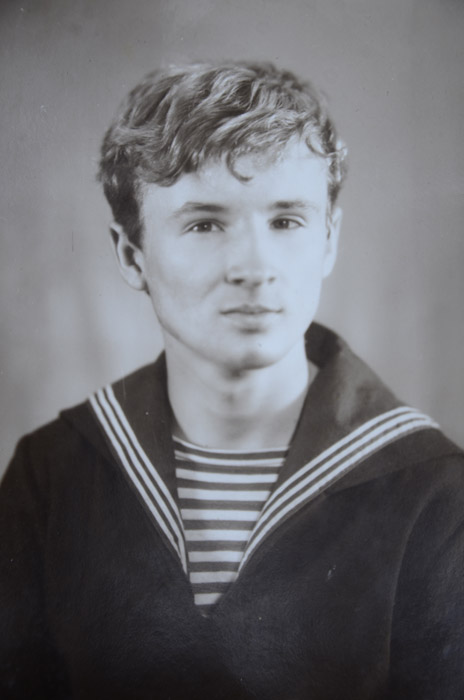
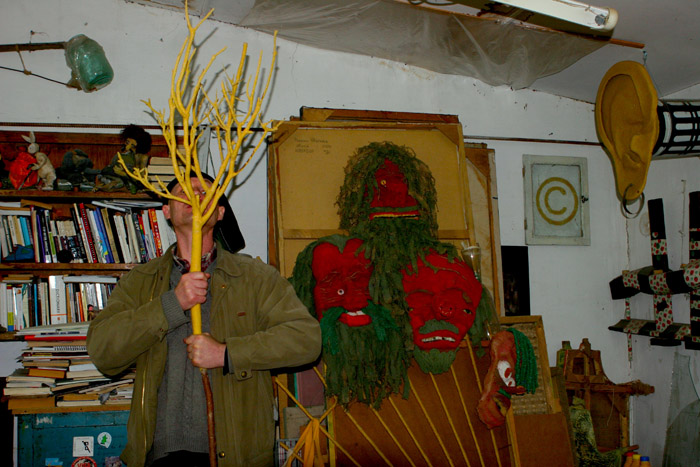
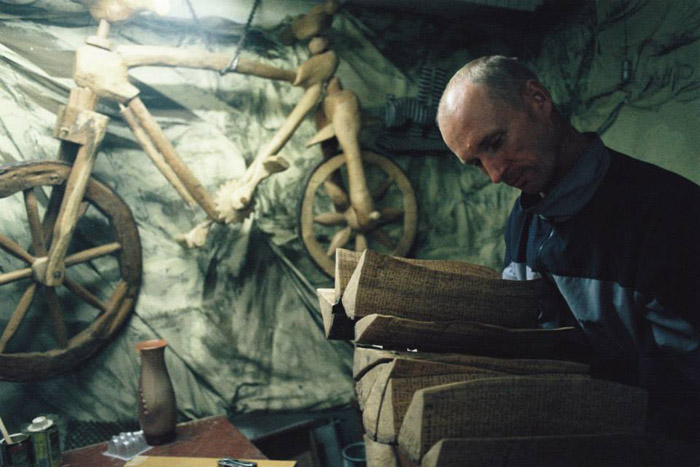
Ghenadie does not live on his own in this old and cold space. “The zebrophones” for instance – twenty black and white, stripy beings-chairs with radios inside them, “are good companions for traveling”, Ghenadie explains. When you're bored and lonely and away, you turn on the radio and you hear a word or two, hopefully in your language. Marx, Engels, Lenin and Hitler also made it in Ghenadie's studio, as evil masks. Big and red and slimy. To scare the devil. They're stuck next to a massive ear glued to a black and white Chisinau-style bin. The ear listens to all the rubbish and the suffering people have to get out of their chests. I tell him that it reminds me of the McDonalds' inscription on the bins encouraging its clients to throw away all their worries and laptops, although the ear-bin is much more sculptural. In the opposite side, close to where Ghenadie sleeps under a few wooden shelves, some individuals from other planets, with massive hands, twice the size of their bodies. This is the way they are on their planet, explains Ghenadie.
A couple of years ago, Ghenadie told me that “Comfort destroys. In comfort, you don't understand much. When you walk by foot, the rain falls on you, you feel a straw, you get scratched.” Now, he sees comfort as a human, or rather, an “epidermic” necessity. It may be the age, my parents would say. But Ghenadie still thinks experience is more important than comfort.
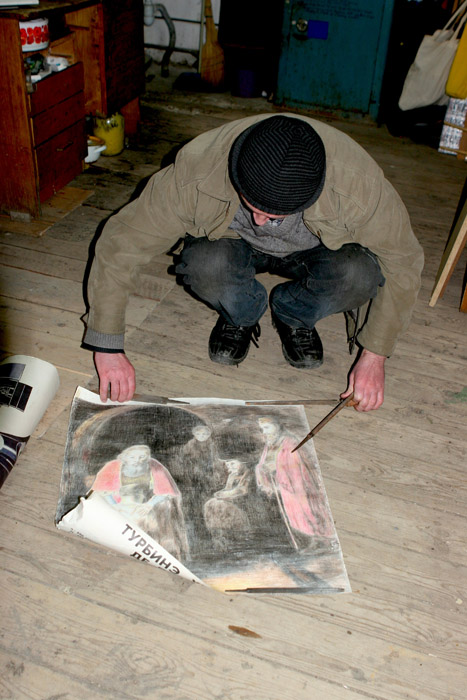
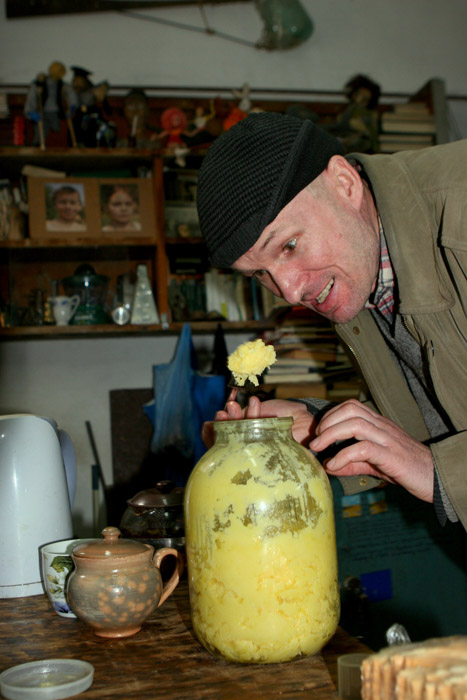
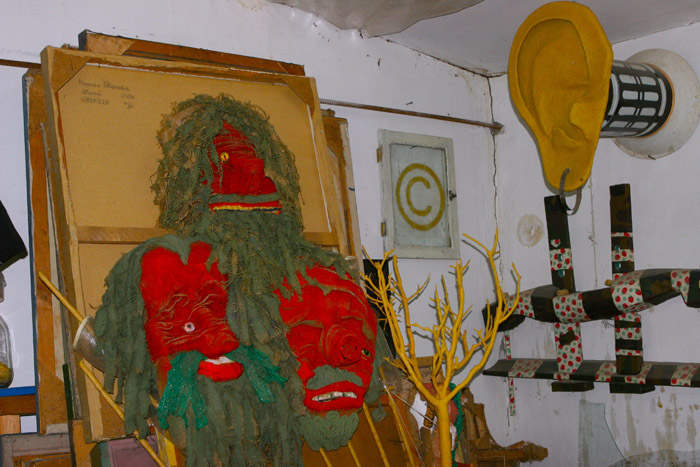
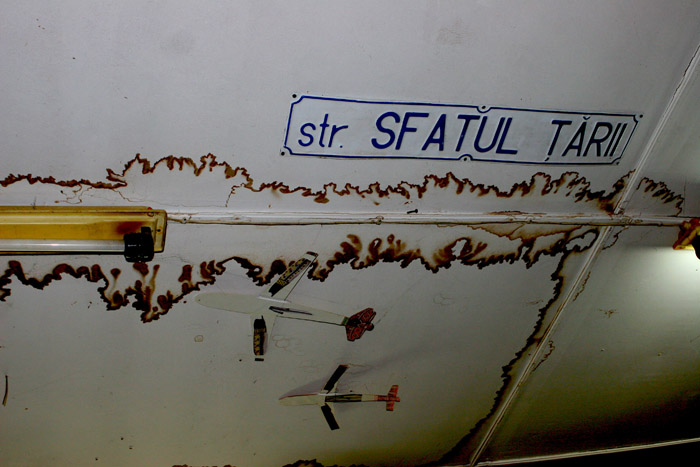
“At the speed of the wheelbarrow, you observe”
One of Ghenadie's most interesting performances is his walk with the wheelbarrow through Moldova and Poland. How did the idea of the wheelbarrow trip come? “According to the Moldovan work law code, people are free only thirty days per year”, he says. “And what do they do then? They go to all-inclusive hotels from which they can't get out. In countries they'd never seen before.” Yes, that sounds exactly like the paradise the Moldovan middle class dreams of every summer – non-places, if I may use this anthropological trope, in all-inclusive hotels in Bulgaria, Turkey and sometimes even Egypt. “I chose to go with the wheelbarrow through my own country. From the North to the South, for twelve days. In Romanian, a wheelbarrow is also the feminine for 'slave'. It's so appropriate. Like in no other language.” Ghenadie speaks his own poetry as naturally and unpretentiously as he wears his daily working clothes. “With the wheelbarrow, you exchange fleas with the passers by”, Ghenadie responds to my much more boringly formulated question about the great conversations he had on his wheelbarrow tours. “Conversation is the bright side of walking with a wheelbarrow, with all its mosquitos and all the tiredness – we haven't been nomadic for a long time now”. Ghenadie's tone when he says that we haven't been nomadic is of a child who explains why his family hasn't gone on a holiday this summer. Back to my question: “A man with a wheelbarrow is a peaceful image”, continues Ghenadie. “A man next to a man with a wheelbarrow is open for confession instantly. So the people I encountered told me the kind of stories one tells someone they will never see again. They also jubilated at the thought that they weren't as strange as me. Or they asked me “what do you sell?” and “how much is it?”.” On the residence in Poland, it was more difficult to make the trip because of the language barrier. But in Austria, Ghenadie recalls, a couple hosted him in their hotel for free – and they were so happy to have at least one client that they also fed him and gave him to drink. Just like in a parable about Saint Peter.
Treating the Water
Ghenadie went to speak to the water. His great passion is the sea, but since Moldova doesn't have a sea, he went to the river. “How do we treat our rivers? We wash our cars in them, throw garbage in them, and make artificial lakes out of them”, Ghenadie criticises without losing any of the softness in his voice. He made himself a suit and a ship out of checkered plastic bags that fill the Moldovan market up to the brim that is your eyes, nostrils and gastric necessity for beauty, as a poet put it. And thus packed, he went to the river to read the country's legislation on ecology to it. “People keep asking me – what do you get out of it? And I say. I open up the navigation on the Bic river, I've built my own ship”. The Bic river crosses the capital very near its centre. In any other city, a riviera would immediately be built. In Chisinau, the central part of the river reaches two palms in its width at some points. Although some of the more cosmopolitan Moldovans have started to eat vegetarian diets, recycle their bottles and even go out once a year to clean the green spaces, no significant and well-thought attempts have been made to protect and develop the country's rivers. Ghenadie explains: “The first 50 kilometers of the river Bic have no water. The river Ichel is half dry. We're poor – we have an excuse.” And Ghenadie seems to be the only person bothering about it in Moldova.
How did Ghenadie's passion for water begin? I was waiting for an answer that goes back to the mother and the beginnings of the world. Instead, Ghenadie brought me back to the ground: “I read adventure books as a child, at that age that longs after fret. I read about pirates and I really wanted to spend my life at the sea. So I thought: I will join the marine.” So he was a boy too, I think and smile to myself, he hasn't always been as concerned with meaning and society. “They told me I could also do medicine. But I didn't have the strength to resist as a doctor. So I applied to the marine – I knew all the schools that offered it.” But Ghenadie's first dream soon got crushed remorselessly: he had a bad sight, so no marine school would take him. “So then I went to the construction polytech in Chisinau.” (What?!) “Only after a couple of months I started spending most of my time in Odessa [a Ukrainian little and picturesque port 200 kilometers away from Chisinau], by the sea, sleeping in railway stations.” Ghenadie's vagabondism is as surprising to me as all of his life story, but it makes so much sense.
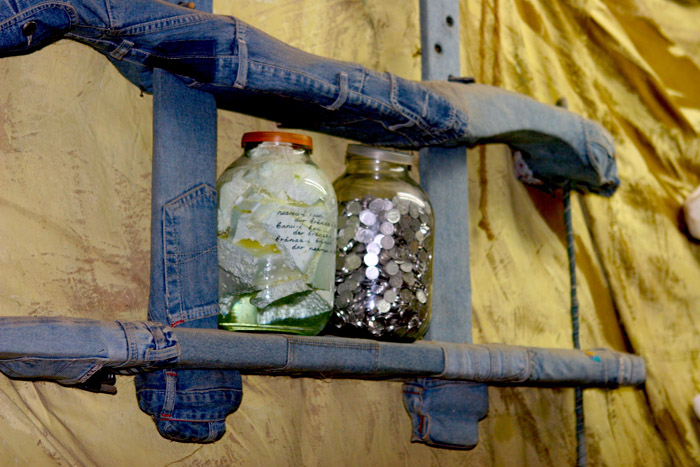
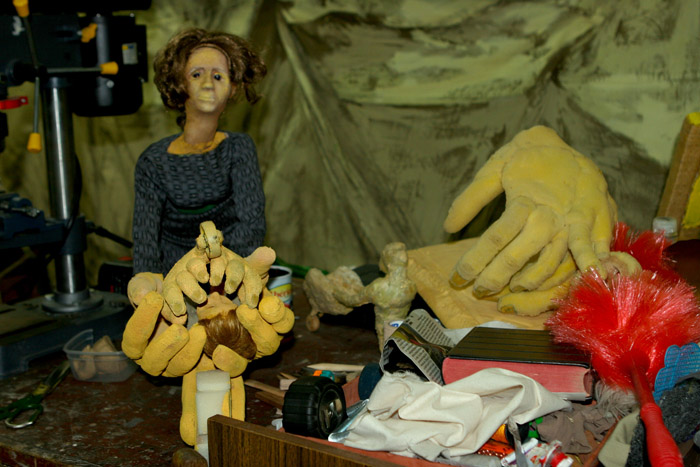
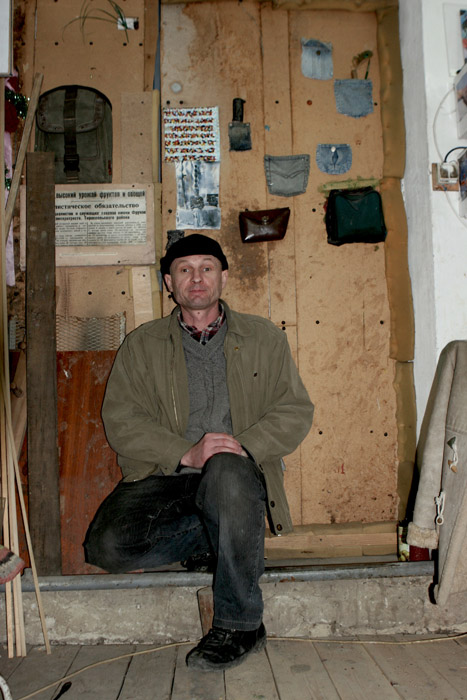
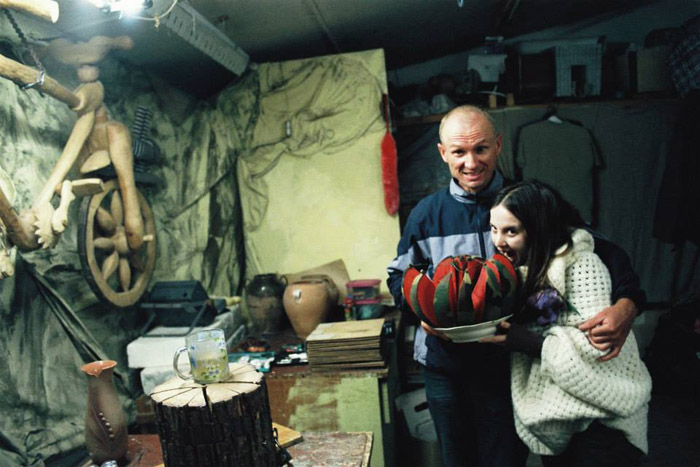
“As a vagabond, I felt like I didn't sip the air, but bit it!”
“I learned how to deal with policemen, how to trick them. I didn't think that the future is something that springs from the present. I didn't have the right people to guide me then”, he says without any resentment. Ghenadie's parents, living in a little village in the North of Moldova, couldn't do much to match their son's fancies to the world they knew. His mother was a primary school teacher, and his father was the school's facilities manager. He never read a book in his life. But when he got drunk, he liked to observe and celebrate the beauty around him.
The first serious book that really shook him was precisely about a vagabond youth. He doesn't remember the name of the author or the title of book, but he knows that it told him something important about the life he was witnessing.
Funciarii (The Landed) from ghenadie popescu on Vimeo.
VIDEO: Popescu's Animation “The Landed”
The Break of USSR, the army & the girlfriend sending different love letters
“There was an uncle who tried to help me. He was of the nomenklatura and told me to go to a Commercial College and that he would then help me. But he was the kind of person for whom material comfort was the only thing that mattered and I didn't accept his help because I didn't want to become like him.”
Herein came the Soviet system's salvation of making boys into men: the army. Structure, hierarchy and discipline. But Ghenadie was lucky enough to have a smoother time in the army in Kaliningrad. He did pointless military exercises in the first half year of 1989, and then made accumulators for helicopters until 1991.
“I missed the movement for independence”, he says matter-of-factly. “The flower bridge [a 1991 symbolic act of reunification between Romania and Moldova after they had been separated by a Soviet annexation of Moldova in 1941] and all that. I only knew that something was going on when my girlfriend started writing her letters to me in the Latin and not the Slavonic alphabet.” To this mild awareness of the break of the USSR, one must add that for the majority of Ghenadie's generation, the movement for independence from Moscow had been the loudest and most tumultuous period of their lives.
“I came back from the army and the USSR was gone. There was poverty here and nothing else. My uncle was a businessman now. He tried to help me again, getting me into a Commercial College. I refused yet again and he got upset. So I worked the land for a while.
“Any art is interesting through its blunders. Anything becomes decorative at a certain point”
And how did art came about? I ask in expectation. “I was bored”, Ghenadie bluntly answers. “In the kolhoz, there was nothing to do. Work the land, drink with friends from time to time. By 1994 we didn't have electricity most nights, so we couldn't even read or watch TV any longer. Work the land, drink. What else? I started drawing. There was nothing in that village, so I used coloured pencils. One of my first drawings was a copy of Rembrandt's 'The Return of the Prodigal Son', made in coloured pencil and on the back of a Physics lab poster [of a hydraulic engine]. My sister used to work in the Physics lab, so she gave me the poster.”
Then the angels came and Ghenadie managed to get into the Academy of Art, just a few streets down from the Museum of Ethnography, as a student attending the classes illegally. Ghenadie does not want to get into the details. “There have been people who really helped me later on. But angels are an alterable substance. They can't stay in your life for long.”
How did he take conceptual art after his classical education at the Academy of Art? “I was at home in conceptual art”, he says simply. Does he follow the international art scene? Ghenadie chooses the artists to follow carefully – they range from Latin American writers to Russian films and European animation. “I constantly look at what they do, and sometimes get jealous that they've managed so much. And I try to do more myself”, he says.
Whilst so many conceptual artists, be they in London, Berlin or Chisinau, are constantly referring to the art world, Ghenadie draws from his life and the world around him. “Artists in Chisinau know that they can get money for public space projects. And they do projects about the public space. They did a street chalk drawing, made a video, wrote a manifesto, made a video. What next? Is that true experience?”
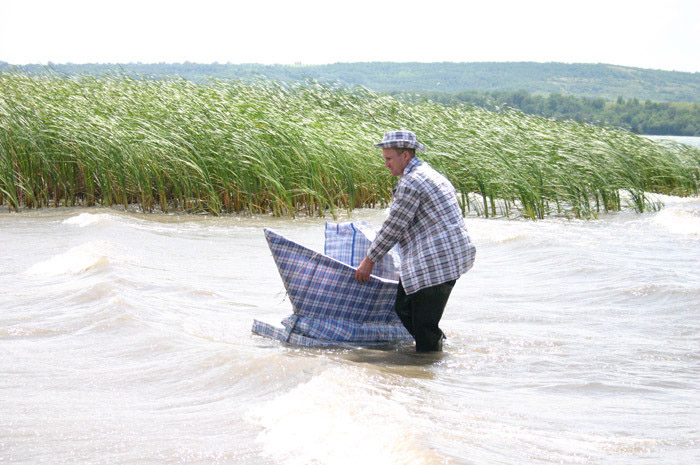
“It's time to go”
I went through an existentialist phase in which I thought that Ghenadie is the only authentic person in the world. Now I've become a little less radical. I ask Ghenadie what his parents feel about his way of life. “Now that they've seen me on TV a couple of times, they've calmed down thinking that I'm normal. But they're still upset that I haven't found my other half, that I don't have a car.” I can't imagine Ghenadie ever changing. He seems so timeless as he is. It's even strange that he has a biography. But he says - “I've been in this place for ten years. It's too much. It's time to go”. So the fantastic folk tale of Ghenadie Popescu may take new and unexpected turns yet again.
Subscribe to our mailing list: